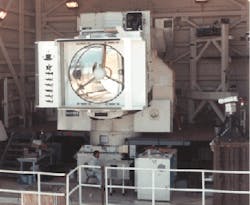
Better defense or a new arms race? That is the question raised by the US Department of Defense (DoD) first test of a megawatt chemical laser to disable a US satellite in space.
The Army`s ground-based Mid-Infrared Advanced Chemical Laser (MIRACL) is a byproduct of the $40 billion Strategic Defense Initiative program. Based at the High Energy Laser Systems Test Facility on the White Sands Missile Range in southern New Mexico, MIRACL is a megawatt-class, continuous-wave, deuterium fluoride chemical laser. It burns ethylene (C2H4) with the oxidizer nitrogen trifluoride (NF3) to produce free, excited fluorine atoms as one of the combustion products. Deuterium and helium are then mixed into the exhaust to produce vibrationally excited deuterium fluoride (DF) molecules, while the helium stabilizes the reaction and controls the temperature. MIRACL, the highest-average-power laser in the USA, emits ten lasing lines between 3.6 and 4.2 µm. Since 1980, the laser has accumulated more than 3000 s of total lasing time in 150 tests; its maximum lase duration is 70 s.
Beam-shaping optics produce a 14-cm-square beam that is propagated through the rest of the beam train; the SEALITE beam director, a 1.8-m-aperture gimbaled telescope and optics, capable of focusing from 400 m to infinity, points the MIRACL laser beam onto a target, while a set of infrared (IR) and visible sensors is used to acquire and track the target (see photo). The integrated system can focus and aim the beam on a moving target and keep the beam at the same position as long as necessary. At the target, the IR beam is expected to be about 6 ft wide.
In previous tests, MIRACL has successfully demolished speeding drones and rockets in flight. The goal of the most recent test was to disable the $60 million Miniature Sensor Technology Integration satellite, MSTI-3, launched in May 1996, which the US Air Force said it no longer needed—despite protests from the maker of the satellite, Spectrum Astro (Gilbert, AZ), which said the satellite had commercial value for customers seeking surface images for crop forecasting and environmental monitoring.
Total destruction of the satellite, about the size of a refrigerator and 260 miles above the Earth`s surface, would have exposed other satellites and spacecraft to potentially dangerous debris. It is not known if key results—such as the success in tracking the rapidly moving satellite and the atmospheric distortion of the beam—from the test will ever be released.
Offense or defense?
The purpose of the test, according to the DoD, was to collect data that will be used to improve computer models used for planning protection measures for US satellites. In October a DoD spokesman said, "Increasingly, the department looks to technologies that are satellite-based for its various weapon systems and for its doctrine, and certainly it is prudent for the department to seek measures that will make our satellite systems as safe as possible and protect them from any outside interference." But officials acknowledge that the information gathered could also be used to develop an offensive, antisatellite laser weapon.
Some observers believe the test is a mistake that could backfire and ultimately threaten the USA`s own surveillance satellite system. "At best, the MIRACL test is unnecessary," said Steven Aftergood, an analyst with the Federation of American Scientists. "There is no indication that potential adversaries such as North Korea, Iraq, or Libya are constructing enormous antisatellite lasers. . . . At worst, the MIRACL test is foolish. It violates a long-standing taboo on the active disruption of orbiting spacecraft that has served the United States well over the years. As the nation that is most heavily dependent on orbital assets, we have the most to lose by validating an antisatellite regime."
Ret. Adm. Eugene Carroll, deputy director of the Center for Defense Information, likened the proposed test to past military "hubris" involving the multiple-warhead program MRV, a technology it was assumed the Soviets could not match. Yet today there are 1200 Russian missiles with 6000 warheads. Carroll said that then Secretary of State Henry Kissinger was reported to say, "I wish I had thought through the consequences of MRVing more completely." Carroll said, "That expresses, in my opinion, that we didn`t close off this foolish step in the arms race."
An important unspoken—by the DoD—motivation for the MIRACL test is thought to be the approaching wave, already underway, of commercial spy and reconnaissance satellites that will offer earth images to private buyers. India`s IRS-1 satellite, available since 1995, can already image details down to 6 m, and EarthWatch (Longmont, CO) will soon offer 3-m-resolution images for purchase over the Internet. Space Imaging EOSAT (Thornton, CO) plans to launch the first commercial satellite with 1-m resolution, this December, and EarthWatch`s 1-m program, QuickBird, is scheduled to launch in 1998. Such satellites are expected to be of great interest to a variety of countries, military organizations, and private companies.
About the Author
David Appell
Assistant Editor, Technology
David Appell was Assistant Editor, Technology for Laser Focus World.